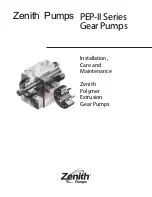
VIII. Maintenance
13
Brush inspection and replacement
Replace both carbon brushes when either has less than 1/4" of carbon remaining. To inspect
or replace, unplug the cut-off saw, remove the carbon brush cap on the side of the motor
housing, and pull out the brush (
Note
: the cap is spring-loaded). Repeat the steps on the
other side. To reassemble, reverse the procedure.
Replace the laser module batteries
(Fig. 13)
1. Remove the 3 screws that secure the laser
module cover to the housing. Remove the cover,
taking care not to damage the wires connected to
the laser switch.
2. Remove the 2 screws
(1)
that secure the battery
cover to the battery case. Remove the battery
cover.
3. Replace both "AAA" batteries
(2)
.
Lubrication
ATD tools are properly lubricated at the factory and are ready to use. When necessary,
lubricate only those parts that pivot or move with a dry silicone spray. Lubricating
motor bearings and other internal parts should be done only by qualified service technicians.
General maintenance
Before each use, inspect the guards, switches, power cord, and extension cord. Check for
loose screws, jamming, improper mounting, broken parts, and any other condition that may
affect the safe operation of the cut-off saw. If an unusual operating noise or vibration occurs,
turn the cut-off saw OFF and immediately correct the problem before using the cut-off saw
again.
Cleaning
Clean dust and debris from vents, tabletop, and vise screw. Use a dry, clean rag to clean all
areas of the cut-off saw. Never use solvents or other harsh chemicals for cleaning as they
are harmful to plastic and other insulated parts. Petroleum-based products, brake fluid,
thinners and ammonia detergents will also permanently damage the cut-off saw.
WARNING:
TO AVOID INJURY FROM UNEXPECTED START-UP OR ELECTRICAL
SHOCK, UNPLUG THE POWER CORD BEFORE ATTEMPTING INSPECTION OR
MAINTENANCE. DO NOT USE A DAMAGED CUT-OFF SAW.
WARNING:
NEVER USE FLAMMABLE OR COMBUSTIBLE SOLVENTS AROUND THIS
CUT-OFF SAW. WHEN SERVICING, USE ONLY IDENTICAL ATD REPLACEMENT PARTS.
USE OF ANY OTHER PARTS MAY CREATE A HAZARD OR CAUSE PRODUCT FAILURE.
Fig. 13
1
2


































